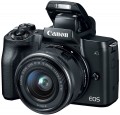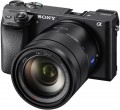DxOMark rating
The result shown by the camera in the DxOMark ranking.
DxOMark is one of the most popular and respected resources for expert camera testing. According to the test results, the camera receives a certain number of points; The more points, the higher the final score.
Total MP
The total number of individual light sensitive dots (pixels) provided in the camera's sensor. Denoted in megapixels - millions of pixels.
The total number of MPs, as a rule, is greater than the number of megapixels from which the frame is directly built (for more details, see "Effective number of MPs"). This is due to the presence of service areas on the matrix. In general, this parameter is more of a reference than practically significant: a larger total number of MPs with the same size and effective resolution means a slightly smaller size of each pixel, and, accordingly, an increased likelihood of noise (especially at high ISO values).
Light sensitivity (ISO)
The sensitivity range of a digital camera matrix. In digital photography, light sensitivity is expressed in the same ISO units as in film photography; however, unlike film, the light sensitivity of the sensor in a digital camera can be changed, which gives you more options for adjusting shooting parameters. High maximum light sensitivity is important if you have to use a lens with a low aperture (see Aperture), as well as when shooting dimly lit scenes and fast-moving objects; in the latter case, high ISO allows you to use low shutter speeds, which minimizes image blur. However, note that with an increase in the value of the applied ISO, the level of noise in the resulting images also increases.
Mount (bayonet)
The type of bayonet mount — mount for interchangeable lenses — provided in a SLR or MILC camera (see "Camera type"). Bayonets come in different sizes, and interchangeable lens specifications usually indicate which mount it is designed for. Most often, mounts of different types are not compatible with each other, but there are exceptions (sometimes directly, sometimes using adapters).
Also note that one brand can use different mounts for different classes of cameras — and vice versa, one mount can be used by several manufacturers. So, Canon releases cameras with mounts
EF-M,
EF-S,
EF and
Canon RF. Leica has
Leica M,
Leica SL,
Leica TL. Nikon has in its arsenal
Nikon 1,
Nikon F,
Nikon Z. Pentax —
Pentax 645,
Pentax K, Pentax Q. Samsung offers
NX and NX-M mounts. Sony cameras have
Sony A and
Sony E, Fuji has
Fujifilm G and
Fujifilm X. And as an example of a mount used by different brands, one can cit
...e Micro 4/3, which is widespread in Olympus and Panasonic cameras.Aperture
Aperture of the lens installed in the camera or supplied with it in the kit (for models with detachable optics).
In a simplified way, this parameter can be described as the ability of the lens to transmit light - in other words, how much the light flux weakens when passing through the optics. It is believed that two main indicators affect the characteristics of light transmission: the size of the relative opening of the lens and its focal length. Aperture is the ratio of the first indicator to the second; in this case, the size of the active hole is taken as one and is generally omitted when recording, as a result, such a recording looks, for example, like this: f / 2.0. Accordingly, the larger the number after the fraction sign, the lower the aperture ratio, the less light the lens transmits.
Zoom lenses (zoom lenses), as a rule, have different aperture values for different focal lengths. For such optics, two values of this parameter are indicated in the characteristics, for the minimum and maximum focal lengths, for example, f / 2.8–4.5. There are also vario lenses that maintain a constant aperture over the entire range of focal lengths, but they are much more expensive than analogs with variable aperture.
The high light transmission of the lens is important if the camera is planned to be used for shooting in low light conditions or for shooting fast moving objects: high-aperture optics allow you to shoot at low sensor sensitivity (which...reduces the likelihood of noise) and at low shutter speeds (at which moving objects are less blurry) . This parameter also determines the depth of field of the imaged space: the higher the aperture ratio, the smaller the depth of field. Therefore, for shooting with artistic background blur (“bokeh”), it is recommended to use fast lenses.
Focal length
Focal length of the camera lens.
Focal length is such a distance between the camera matrix and the optical center of the lens, focused at infinity, at which a clear and sharp image is obtained on the matrix. For models with interchangeable lenses (
mirrorless cameras and MILC, see “Camera Type”), this parameter is indicated if the camera is supplied with a lens (“kit”); Let us recall that, if desired, optics with other characteristics can be installed on such a camera.
The longer the focal length, the smaller the viewing angle of the lens, the higher the degree of approximation and the larger the objects visible in the frame. Therefore, this parameter is one of the key for any lens and largely determines its application (specific examples are given below).
Most often in modern digital cameras, lenses with a variable focal length are used: such lenses are able to zoom in and out of the image (for more details, see "Optical Zoom"). For "DSLRs" and MILC, specialized optics with a constant focal length (fixed lenses) are produced. But in digital compacts, "fixes" are used extremely rarely, usually such a lens is a sign of a high-end model with specific characteristics.
It should be borne in mind that the actual focal length of the lens is usually given in the characteristics of the camera. And the viewing angles and the general purpose of the optics are determined not only by this parameter, but also
...by the size of the matrix with which the optics are used. The dependence looks like this: at the same viewing angles, a lens for a larger matrix will have a longer focal length than a lens for a small sensor. Accordingly, only cameras with the same sensor size can be directly compared with each other in terms of lens focal length. However, to facilitate comparisons in the characteristics, the so-called. EGF - focal length in 35 mm equivalent: this is the focal length that a lens for a full frame matrix having the same viewing angles would have. You can compare by EGF lenses for any matrix size. There are formulas that allow you to independently calculate the equivalent of 35 mm, they can be found in special sources.
If we talk about a specific specialization, then the EGF up to 18 mm corresponds to ultra-wide-angle fisheye lenses. Wide-angle is considered "fixed" optics with EGF up to 28 mm, as well as vario lenses with a minimum EGF up to 35 mm. Values up to 60mm correspond to "general purpose" optics, 50 - 135mm are considered optimal for shooting portraits, and higher focal lengths are found in telephoto lenses. More detailed information about the specifics of various focal lengths can be found in special sources.Optical zoom
The magnification factor provided by the camera by using the capabilities of the lens (namely, by changing its focal length). In models with interchangeable lenses (see “Camera type”), indicated for the complete lens, if available.
Note that in this case the magnification is indicated not relative to the image visible to the naked eye, but relative to the image produced by the lens at minimum magnification. For example, if the characteristics indicate an optical zoom of 3x, this means that at the maximum magnification, objects in the frame will be three times larger than at the minimum.
The degree of optical zoom is directly related to the range of focal lengths (see above). You can determine this degree by dividing the maximum focal length of the lens by the minimum, for example 360mm / 36mm=10x magnification.
To date, optical zoom provides the best "close" image quality and is considered to be superior to digital zoom (see below). This is due to the fact that with this format of work, the entire area of \u200b\u200bthe matrix is constantly involved, which allows you to fully use its capabilities. Therefore, even among low-cost models, devices without optical zoom are very rare.
Exposure compensation
The ability to manually (or automatically, according to predetermined parameters) change the exposure parameters during shooting, that is, the amount of light falling on the matrix. It is used when the automatically selected exposure parameters do not give a satisfactory result — for example, in difficult conditions, when the illumination of the main subject and the background is very different. The camera's exposure compensation capabilities are recorded in the format "± x EV, in y EV increments", such as "± 3 EV, in 1/2 EV increments". The first digit indicates the maximum amount by which the exposure can be changed from the original value by the compensation process; the second is the step (step) with which the change occurs. EV is a specific unit of measure for exposure; a 1 EV change in exposure means a 2x change in the amount of light hitting the sensor. An increase in EV indicates an increase in the amount of light due to opening the aperture or an increase in shutter speed, a decrease indicates the opposite. All modern cameras with exposure compensation function are capable of producing it “in both directions”.
Auto bracketing
Bracketing is called shooting a series of frames, in which in each next frame the shooting parameters (exposure, white balance, focus, etc.) change by a certain amount. This allows, for example, to choose the most successful shot from several options, or to determine the effect of changing the settings in one direction or another. Auto bracketing allows you to take such shots automatically. At the same time, it should be taken into account that the set of parameters changed in the process may differ in different camera models. For example, some devices are able to change only the exposure, others — the exposure and/or white balance, etc.

